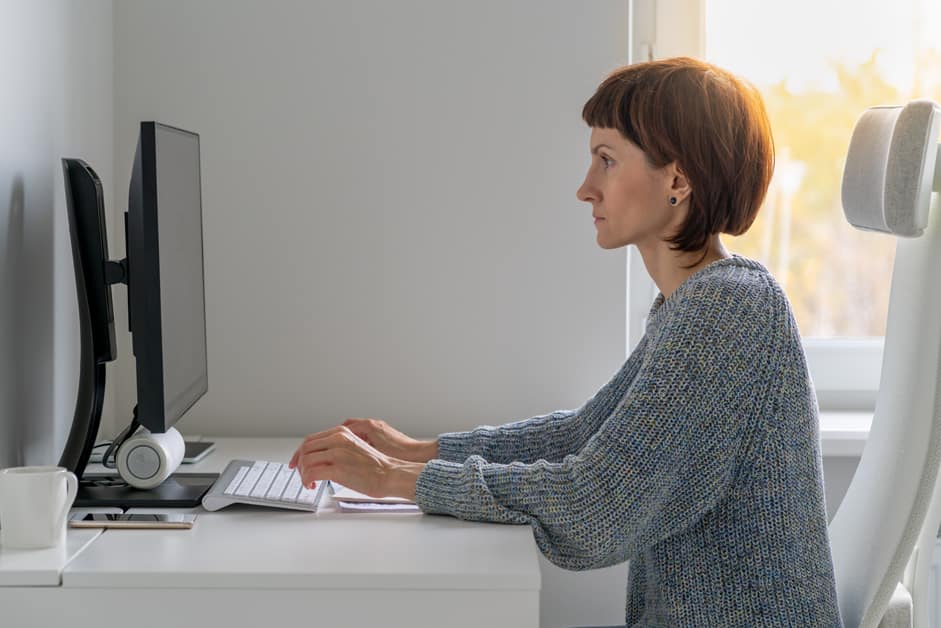Introduction
The modern world has us sitting down for long hours, leading to knee pain and injury. Ergonomics to the rescue! This guide will take you through the basics of how proper posture, seat height adjustments, and other ergonomic adaptations can ease knee discomfort. Many people have found success with ergonomic solutions in reducing stress on their knees. So, if you want to stay focused on your tasks and free from pain, try some ergonomic practices!
What is Ergonomics?
Ergonomics is a science focused on designing and organizing tasks, work environments, and tools to meet the needs of workers. It is the practice of applying scientific knowledge and guidelines to boost worker health, ease, and happiness. Ergonomics considers the physical, cognitive, and organizational elements of a job to improve worker safety and performance.
Let’s dive deeper into the world of ergonomics and its purpose in preventing knee pain at work.
Definition
Ergonomics is the science of fashioning tasks, jobs, and goods to fit the capacities of the workers doing them. It means creating a workplace and environment suited to both the job and the user.
Ergonomics can be applied in many settings such as offices, factories, kitchens, schools, hospitals and more. By using ergonomic principles at work and home, individuals can reduce strain and fatigue that could lead to musculoskeletal disorders. Ergonomic considerations cover workspace design, equipment use (desks/chairs/keyboards), work practices (posture/body mechanics), pressure on tendons and joints, and lifting techniques.
Four elements are addressed by ergonomics:
- Task design which concentrates on job duties—their goal & achievement—and resources (tools/materials). This may mean rearranging a process chain to adjust to new conditions or addressing any hazards in a workspace prior to beginning projects.
- Workstation design which takes into account physical factors that affect people, such as standing height or body sizing, so that aids like desks/chairs match individual needs better, balancing functional goals with comfort requirements.
- Body mechanics which is about efficient movement through coordinated muscle action, which should be taught to employees so they learn how to move safely in relation to their jobs.
- Posture which deals with positioning oneself for optimal effectiveness in productive tasks, permitting full range motion for difficult tasks done over particular periods of time, thus cutting fatigue & repeat injuries.
Benefits
Ergonomics is the practice of designing and organizing things in the workplace to best suit the needs, abilities and limitations of employees. This ensures that they have access to the tools and resources they need to do their job safely and efficiently, while avoiding fatigue, discomfort or injury.
It’s especially important for offices with multiple people sitting at desks all day. Setting up an ergonomic environment with adjustable furniture, proper placement of equipment, proper lighting and comfortable seats/mats can reduce strain in the lower back, neck or limbs. This leads to improved comfort.
In addition to this, there are many benefits of incorporating ergonomics in the workplace:
- Improved posture: Furniture that is set up appropriately can help maintain good posture and balance your muscles. Poor posture can cause chronic pain or injury, but using ergonomics can prevent it from happening.
- Increased concentration: Uncomfortable chairs or monitors that are too far away can be distracting and reduce efficiency and productivity. Ergonomic chairs adjust easily so you can move between tasks without having to move too much, resulting in improved focus.
- Reduced stress: Sitting all day can be tiring and make it hard to take breaks. Ergonomics enable frequent breaks which relaxes muscles that would otherwise stay tense. This leads to reduced stress levels throughout the workday!
Ergonomic Guidelines for Office Workers
Ergonomics is a must for work. It can help keep you healthy and safe from injury. Make adjustments to your workplace and add some ergonomic practices. This can help reduce the danger of knee pain from sitting or standing too long. This article will provide tips to office workers to prevent knee pain at work:
Chair
Choosing an ergonomic chair is key to preventing knee pain. When buying a chair, look for lumbar support, cushioning, adjustable height so feet can rest flat on the floor, and adjustable armrests. It should also have a recline mechanism.
The chair should be adjustable to match elbow height when typing or using a mouse. If it does not adjust, a cushion or special pad can be used to raise armrests. This will ease strain on wrists and elbows, and help reduce knee pain symptoms in those with arthritis and joint issues.
Desk
For office workers, it’s essential to have the right desk. One set to the right height helps with your posture, reducing the chance of knee pain. Your arms and hands should be at elbow level when typing. A doctor or ergonomist can help find the measurements that fit you best.
A footrest can also help the pressure on your knees. It lifts up your lower legs, relieving the strain. If you work on carpeted floors, a mat under your feet can reduce ankle tension during long hours in one position.
Monitor
When selecting a monitor, think about the ergonomic features. Can it swivel, tilt, pivot and rotate? Does it have adjustable arms and tilt without having to adjust the stand? Also, you can adjust the backlight settings to dim or brighten the display.
The size and resolution of the monitor also matters. Larger ones with higher resolutions are better as they can show more information without needing to scroll up and down.
Sit at a comfortable distance from your screen – an ideal viewing distance is arms-length away. Sitting too close can strain eyesight and neck due to glare, while sitting too far away makes it hard to see text and icons on a small screen.
If using two monitors, mount them side-by-side on either end of your desktop. This will help minimize unnecessary movement when transitioning between tasks.
Keyboard and Mouse
Having correct posture and arm/hand movement is essential to avoid knee strain when working on a computer. The mouse should be within 10 inches of the keyboard, so your arm can be relaxed. Using an ergonomic mouse with different hand shapes like ambidextrous or vertical gives workers more control. A footrest may help if your feet don’t rest comfortably when typing.
Position your keyboard correctly. Your elbows should be bent at 90 degrees and forearms parallel to the floor. Wrists should be straight and hands in line with forearm. Too much pressure on wrists can cause carpal tunnel syndrome. Get a quality adjustable split keyboard for natural hand positions and less fatigue in arms, shoulders, and neck. Use an external keyboard to move away from you to add comfort when changing tasks or entering data.
Ergonomic Guidelines for Industrial Workers
Knee pain is a common problem among industrial workers. To avoid it, preventive measures are essential. Ergonomics can help lessen the risk of injury and discomfort.
In this article, we’ll discuss safety tips for industrial workers to stay healthy. Guidelines include setting up the workstation properly to avoid body stress.
Proper Lifting Techniques
It’s essential for industrial staff to use the right ergonomic methods when lifting, to stop knee and lower back pain. These tips will help secure the workplace and reduce pain while working:
- Stand close to the item you’re picking up.
- Bend your knees and keep your back straight when lifting.
- Use your legs (not your back) to lift.
- Hold the object against you while walking. Don’t carry it away from you or at arm’s length.
- Avoid twisting motions at the waist when carrying heavy items.
- Wear grip protection if carrying sharp or jagged objects, such as scrap metal or glass, that can cut or abrade skin.
- Put items down cautiously, by bending your knees and keeping your back straight, instead of bending your spine or twisting your waist.
- Ask other staff to share the heavy lifting when you can.
- Make sure you know the safe weight limit before lifting anything too heavy – check with management/supervisor.
By following these guidelines, industrial workers can minimize the risk of developing knee and lower back pain. This will have both short-term and long-term advantages for their health and wellbeing.
Use of Appropriate Tools
Employers must give industrial workers the right tools and equipment that are ergonomically designed. When using motorized or non-motorized tools, workers must make sure they are properly adjusted to avoid straining or using wrong muscles. All devices should be adjustable and stay in the right place without extra force.
Workers must use two hands when handling tools, keep them close, and if possible, use height-adjustable tables or platforms for material items. Vibratory tools should come with anti-vibration gloves to lessen fatigue and tension in the hands, wrists and arms.
The workplace should offer support equipment such as scissors/shear lifts and movable trolleys to reduce back pain from lifting items at bad heights. Other ergonomic activities include:
- Taking breaks
- Avoiding postures that need bending too much
- Providing enough ventilation to remove dust particles that can cause irritation.
Proper Posture
Proper posture is key to ergonomics and avoiding knee pain. When seated at a desk, keep your back straight, feet flat and shoulders relaxed. This will help keep your muscles aligned and relaxed throughout your body.
Don’t stay in one position too long. Get up from your chair every 30 minutes and walk around. Set an alarm or calendar reminder. That way, you can stretch your legs for a few minutes. This will keep muscles limber and reduce strain.
Conclusion
To prevent knee injuries, ergonomic practices and equipment should be used. Assess workplace activities and set up workstations to reduce stress on lower limbs. Take breaks, use non-slip mats, maintain good posture. Build strength in major muscles around the knee. If there are any worries about knee pain at work, speak to a doctor or healthcare provider.
Prioritise body health and wellbeing!
Frequently Asked Questions
Q: What is ergonomics?
A: Ergonomics is the science of designing and organizing workspaces, products, and tasks to fit the user. It takes into account the user’s capabilities, limitations, and comfort to help them work more efficiently and safely.
Q: How can ergonomics help prevent knee pain at work?
A: Ergonomics can help to prevent knee pain at work by ensuring that the workspace is designed to minimize strain on the knees. This can include adjusting the height of the workstation, providing support for the knees, and ensuring that the user is in the best position to avoid strain.
Q: What are some tips for ergonomically sound knee pain prevention?
A: Some tips for ergonomically sound knee pain prevention include: making sure the workstation is at the right height and adjusted to fit the user’s individual needs; providing support for the knees; and making sure the user is in the best position to avoid strain. Additionally, taking regular breaks and stretching can help to alleviate knee strain.




